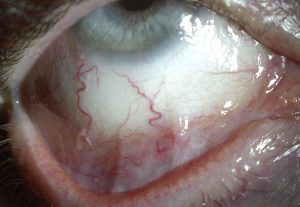
Severe fibrosis after adenoviral conjunctivitis
A failure to correctly diagnose the cause of infectious keratitis and the uncontrolled use of obsolete and ineffective treatments frequently results in eyes developing more severe disease in the Russian population, but authorities are taking steps to correct these problems, said Dmitry Yurevich Maychuk MD, PhD, DMSc, Svyatoslav N. Fyodorov State Institution Eye Microsurgery Complex, Moscow, Russian Federation.
Speaking at a Cornea Day session of the 23rd ESCRS Meeting, in Athens Greece, he noted as an example that acanthamoeba keratitis has such a low incidence in Russia that when it does occur physicians often fail to recognise its early symptoms.
As a result, patients referred to hospitals are often at a more advanced stage of their disease.
CONTACT LENSES
The condition is virtually always associated with extended-wear contact lenses, he said. Common treatments for acanthamoeba are agents like voriconazole and fluconazole, but they are not very effective. Dr Maychuk said he and his colleagues are trying to teach physicians to treat the condition more aggressively from the outset with phototherapeutic keratectomy .
Another problem for patients with contact lenses is the low usage of modern antibiotics in cases of acute bacterial ulcers caused by pseudomonas aeruginosa. Again, physicians fail to recognise the condition and treat it with older agents like chloramphenicol or ofloxacin, which does not stop the corneal melt. However, updated national guidelines now recommend an aggressive treatment programme with the use of newer antibiotics, particularly third- and fourth-generation fluoroquinolones.
Another update in the national guidelines has to do with the treatment of pseudomembranes, which occur in one-in-30 cases of adenoviral keratoconjunctivitis. Many ophthalmologists are afraid to remove them or think that they will resolve spontaneously once the infection is eliminated. However, severe fibrosis occurs in 2.1% of pseudomembranes. Therefore, removal of pseudomembranes is now included in the national treatment protocol for adenoviral keratoconjunctivitis.
Paediatric ulcerative keratitis resulting from chronic blepharitis and allergic conjunctivitis is another condition that is often treated incorrectly in Russia, allowing the disease to advance to a more advanced stage. Parents often treat their children with the condition using over-the-counter antibiotics and antihistamines. By the time an ophthalmologist sees them they will have had the condition for 19 months, Dr Maychuk said.
He noted that in a study of 148 children aged four-to-12 years with ulcers primarily of bacterial origin, 78% were positive with PCR smear for CMV and 42% were positive for HSV. He and his associates have a new treatment protocol that is a viral systemic therapy involving topical steroids and topical cyclosporine that has had good results so far, without any signs of recurrences.
Dmitry Yurevich Maychuk: maychuk@mail.ru

 Severe fibrosis after adenoviral conjunctivitis
Severe fibrosis after adenoviral conjunctivitis